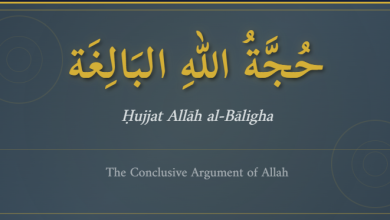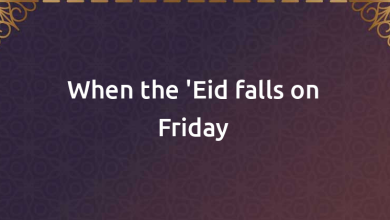Proofs for the Hanafi Procedure of Salat al-‘Id
- Proofs for the Hanafi Procedure of
Salat al-‘Id
Hadith One: A Sahih Marfoo‘ Hadith
Near the end of his Sharh Ma‘ani al-Athar (2:371, Maktabah Haqqaniyyah), Imam al-Tahawi (d. 321 H) narrates:
علي بن عبد الرحمن ويحيى بن عثمان قد حدثانا قالا: ثنا عبد الله بن يوسف عن يحيى بن حمزة قال: حدثني وضين بن عطاء أن القاسم أبا عبد الرحمن حدثه قال: حدثني بعض أصحاب رسول الله صلى الله عليه وسلم قال:
صلى بنا النبي صلى الله عليه وسلم يوم عيد، فكبر أربعا أربعا، ثم أقبل علينا بوجهه حين انصرف، فقال: لا تنسوا كتكبير الجنائز، وأشار بأصابعه وقبض إبهامه
Translation
‘Ali ibn ‘Abd al-Rahman and Yahya ibn ‘Uthman narrated to us, they said: ‘Abd Allah ibn Yusuf narrated to us: From Yahya ibn Hamzah, he said: Wadin ibn ‘Ata’ narrated to me that al-Qasim Abu ‘Abd al-Rahman narrated to him, he said: One of the companions of the Messenger of Allah (Allah bless him and grant him peace) narrated to me, he said:
“The Prophet (Allah bless him and grant him peace) prayed with us on the day of ‘Id, so did takbir, four [in the first rak‘ah] and four [in the second], and then he turned to us with his face when he finished and he said: ‘Do not forget, [the takbirs of ‘Id are] like the takbir of janazah.’ And he gestured with his fingers and clutched his thumb (signalling the number four).”
Meaning
The “four” takbirs of the first rak‘ah mentioned in this narration includes the opening takbir (takbirat al-iftitah) as the Prophet (peace and blessings be upon him) drew a comparison with the takbirs of Janazah in which one of the four takbirs is also of the opening takbir. Furthermore, the four takbirs in the second rak‘ah includes the takbir said when going into ruku‘. Hence, the additional takbirs are in fact six. This meaning is clear from other narrations, some of which are reproduced below.
Authenticity
‘Allamah Badr al-Din al-‘Ayni (d. 855 H) said about this narration: “And this is a sahih chain and its narrators are trustworthy.” (Nukhab al-Afkar, 16:442)
Here is a brief analysis of the narrators in the chain:
- ‘Ali ibn ‘Abd al-Rahman ibn Muhammad ibn al-Mughirah al-Kufi (d. 272 H), the shaykh of al-Tahawi, known by the agnomen “‘Allan,” was also a shaykh of Imam al-Nasa’i, and he is trustworthy (thiqah). He was declared “trustworthy” (thiqah) by Ibn Yunus and is mentioned in al-Thiqat of Ibn Hibban (Tahrir al-Taqrib, 3:49).
- ‘Abd Allah ibn Yusuf al-Tinnisi (d. 218 H) is an undisputed Madinan Hadith authority, whose narrations are found in Sahih al-Bukhari, and the Sunans of Abu Dawud, Tirmidhi and Nasai. He is one of the most reliable transmitters of Malik’s Muwatta’ (Tahrir al-Taqrib, 2:288-9).
- Yahya ibn Hamzah ibn Waqid al-Hadrami (d. 183 H) is thiqah and his narrations are found in all six of the famous hadith collections (Tahrir al-Taqrib, 4:82).
- Al-Wadin ibn ‘Ata’ ibn Kinanah (d.156) is at least saduq (reliable) if not thiqah. Ahmad, Ibn Ma‘in, Abu Zur‘ah, Ibn Shahin, al-Dhahabi and others declared him thiqah. Although some critics said he is weak, this was due to his beliefs associated with qadar (predestination), which does not detract from his strength as a hadith narrator (Tahrir al-Taqrib, 4:59-60).
- Al-Qasim ibn ‘Abd al-Rahman Abu ‘Abd al-Rahman al-Dimashqi (d. 112) was a companion of the famous Sahabi, Abu Umamah al-Bahili, and he is thiqah, described so by al-Bukhari, Ibn Ma‘in, al-Tirmidhi, Juzjani and others (Tahrir al-Taqrib, 3:171).
- Although the Sahabi in this chain is unknown, this does not affect the authenticity of the chain as all Sahabah are trustworthy and reliable by consensus of the Ahl al-Sunnah wa l-Jama‘ah.
Imam al-Tahawi said after narrating the above hadith:
هذا حديث حسن الإسناد وعبد الله بن يوسف ويحى بن حمزة والوضين والقاسم كلهم أهل رواية معروفون بصحة الرواية
“This is a hadith with a hasan chain. ‘Abd Allah ibn Yusuf, Yahya ibn Hamzah, al-Wadin and al-Qasim are all people of transmission, recognised for authenticity in transmission.” (Sharh Ma‘ani al-Athar, 2:371)
Salafi scholar, Al-Albani, said after quoting this statement of al-Tahawi, “It is as he said.” (Silsilat al-Ahadith al-Sahihah, no. 2997)
Hadith Two: The View of Major Sahabah
‘Abd al-Razzaq al-San‘ani narrates in his Musannaf:
عبد الرزاق عن معمر عن أبي إسحاق عن علقمة والأسود بن يزيد قال:
كان ابن مسعود جالسا وعنده حذيفة وأبو موسى الأشعري فسألهما سعيد بن العاص عن التكبير فى الصلاة يوم الفطر والأضحى، فجعل هذا يقول: سل هذا، وهذا يقول: سل هذا، فقال له حذيفه: سل هذا – لعبد الله بن مسعود – فسأله، فقال ابن مسعود:
يكبر أربعا ثم يقرأ فيركع ثم يقوم فى الثانية فيقرأ ثم يكبر أربعا بعد القراءة
Translation
‘Abd al-Razzaq from Ma‘mar (ibn Rashid) from Abu Ishaq (al-Sabi‘i) from ‘Alqamah and al-Aswad ibn Yazid, he said:
Ibn Mas‘ud was sitting and next to him was Hudhayfah (ibn al-Yaman) and Abu Musa al-Ash‘ari, whereupon Sa‘id ibn al-‘As asked these two (i.e. Hudhayfah and Abu Musa) about the takbir in the Salah of the day of Fitr and Adha. So this one began to say, ‘Ask this one,’ and this one to say, ‘Ask this one.’ Then Hudhayfah said to him: ‘Ask this one’ – [pointing] to ‘Abd Allah ibn Mas‘ud. So he asked him. Ibn Mas‘ud said:
“One does takbir four times and then he recites, then he bows, and then he stands in the second (rak‘ah) and he recites, and then he does takbir four times after recitation.” (Musannaf ‘Abd al-Razzaq, no. 5687, 3:293-4, al-Majlis al-‘Ilmi)
Authenticity
This is a very strong chain of narration, with all the narrators being known hadith authorities, found in all six of the famous hadith collections.
Comment
This proves ‘Abd Allah ibn Mas‘ud prayed in the way described in the above hadith, and he issued fatwa on it. And major Sahabah agreed with him. It is also established in other narrations that Ibn Mas‘ud’s students, like ‘Alqamah, Aswad, Masruq and others, would also pray in the same way.
Hadith Three: A Clearer Description
If there is some confusion and ambiguity in the above descriptions regarding the tabkirs, the following hadith makes the procedure completely clear:
Ibn Abi Shaybah narrates:
حدثنا وكيع عن سفيان عن أبي إسحاق عن عبد الله بن أبي موسى…أن أميرا من أمراء الكوفة…بعث إلى عبد الله بن مسعود وحذيفة بن اليمان وعبد الله بن قيس فقال: إن هذا العيد قد حضر فما ترون؟ فأسندوا أمرهم إلى عبد الله، فقال:
تكبر تسعا: تكبيرة تفتتح بها الصلاة‘ ثم تكبر ثلاثا، ثم تقرأ سورة، ثم تكبر ثم تركع ثم تقوم فتقرأ سورة ثم تكبر أربعا تركع بإحداهن
Translation
Waki‘ (ibn al-Jarrah) narrated to us from Sufyan (al-Thawri) from Abu Ishaq (al-Sabi‘i) from ‘Abd Allah ibn Abi Musa…that an emir from the emirs of Kufah…sent for ‘Abd Allah ibn Mas‘ud, Hudhayfah ibn al-Yaman and ‘Abd Allah ibn Qays (i.e. Abu Musa al-Ash‘ari) and he said: ‘Indeed ‘Id has come, so what is your opinion?’ They deferred their matter to ‘Abd Allah, and he said:
“You do nine takbirs: one takbir with which to open the Salah, and then you do three takbirs, and then you recite a surah, and then you do takbir and then you bow, and then you stand (in the second rak‘ah) and you recite a surah, and then you do four takbirs and bow with one of them.”
Comment
This is a very clear description of the Hanafi procedure of Salat al-‘Id.
Authenticity
Again, this is an authentic chain. ‘Abd Allah ibn Abi Musa is a very senior Tabi‘i whose narrations are found in Sahih Muslim, and he is thiqah (Taqrib, no. 3547).
Concluding Remarks
Further Support
Furthermore, there is an authentic narration in Musannaf Ibn Abi Shaybah (no. 5757) that ‘Abd Allah ibn ‘Abbas, the great Makkan Sahabi, also prayed in this way.
Hadiths on the Other Opinion of “Seven and Five” Takbirs
Finally, Imam al-Tahawi criticises all the narrations that say the Prophet (Allah bless him and grant him peace) prayed “seven and five,” as they all have problematic narrators in the chains like Kathir ibn ‘Abd Allah, ‘Abd Allah ibn ‘Abd al-Rahman al-Thaqafi and Ibn Lahi‘ah, and some have inconsistency (idtirab) in the chain. And he says the narration above (hadith one) is free of these defects that are found in those narrations that mention “seven and five.”
Furthermore, the narration above (hadith one) also contains a verbal instruction from the Prophet (peace be upon him) i.e. his saying, “Do not forget, four like the takbirs of Janazah.” And it is known that a verbal hadith is given priority over ones that only describe a practice.
Hadiths on the Position of ‘Abd Allah ibn Mas‘ud in this Ummah
Another important fact that gives support to the Hanafi method is that it was championed by the eminent Sahabi, ‘Abd Allah ibn Mas‘ud (may Allah be pleased with him). Consider the following two narrations:
Al-Hakim narrates in his Mustadrak (3:319) with his chain that the Prophet (peace be upon him) said:
رضيت لكم ما رضي لكم ابن أم عبد
“I am pleased for you with what Ibn Umm ‘Abd (i.e. Ibn Mas‘ud) is pleased for you.”
Al-Hakim said it is sahih and al-Dhahabi agreed with him. Muhammad ‘Awwamah analysed the chain and showed it is authentic (footnotes to Musannaf Ibn Abi Shaybah, 17:193) Al-Albani also deemed it authentic (Silsilah Ahadith Sahihah, no. 1225).
And the Prophet (peace be upon him peace) said:
وتمسكوا بعهد ابن أم عبد
“Hold fast to the instruction of Ibn Umm ‘Abd (i.e. Ibn Mas‘ud).”
It was narrated by al-Tirmidhi, Ahmad, al-Tahawi, Ibn Abi Shaybah and others. Shu‘ayb al-Arna’ut stated it is a “sahih hadith” (footnotes to Sharh Mushkil al-Athar, no. 1224)
This, therefore, is a validation from the Prophet (peace be upon him) himself to follow the verdicts and teachings of ‘Abd Allah ibn Mas‘ud.
————————
Courtesy of Here






